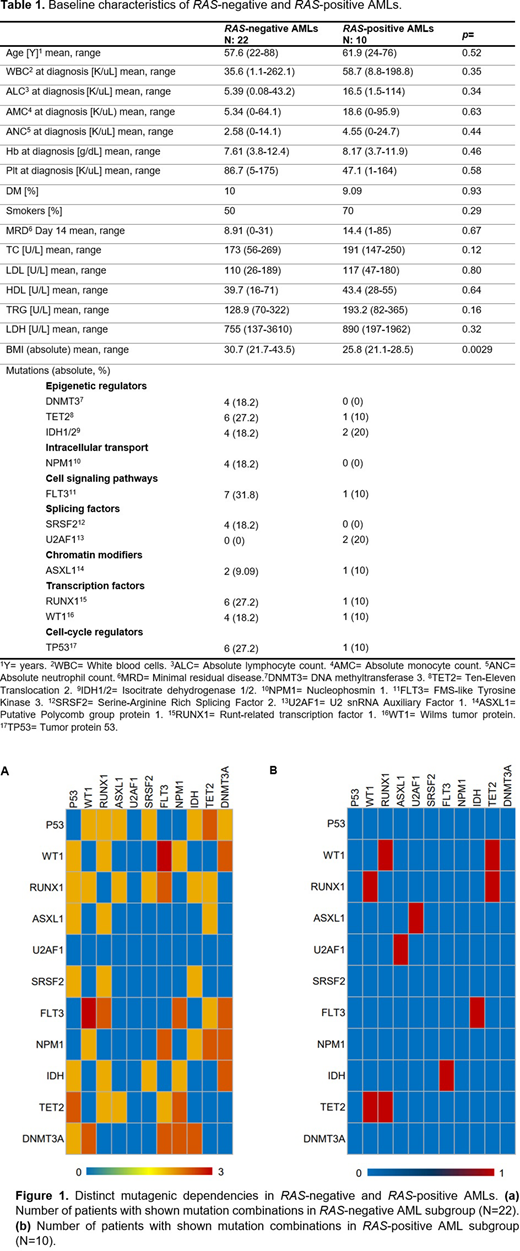Background: Acute Myeloid Leukemia (AML) is associated with mutational diversity. Previous studies have shown that obesity has strong links to genomic instability directly through metabolic parameters, or indirectly through inflammation-mediated pathways, and is thereby strongly associated with cancer initiation. Interestingly, obese patients have been reported to develop fewer mutations and have less dependence on "driver genes" like KRAS in favor of cell signaling alterations in colon cancer. Past work has also shown that transgenic mice have lower cholesterol levels and metabolism resembling the Warburg effect in the liver. We sought to find an association between RAS mutations and obesity in AML with aims to (1) find evidence of a "protective effect" of obesity against the acquisition of RAS (KRAS and NRAS) and (2) detect differential mutational expression among RAS-negative and RAS-positive AML to uncover possible tumor vulnerability.
Methods: After IRB approval, 186 AML patients were screened from Baylor College of Medicine Institutions [Michael E. DeBakey VA Medical Center, and Baylor St. Luke's Medical Center]. 32 patients with next-generation sequencing (NGS) for myeloid mutations, complete blood count (CBC), body mass index (BMI), age, diabetes mellitus (DM), smoking, and lipid data were selected. Differential BMI was estimated by t-test in those with or without RAS mutations. A similar analysis was performed among patients with or without RAS mutations for relevant variables. The logistic regression model was used to independently assess the effect of BMI on RAS acquisition. All statistical analysis was performed using SAS software.
Results: In our cohort, 22/32 [68.7%] and 10/32 [31.3%] patients had RAS-negative and RAS-positive AMLs, respectively. Differential expression for CBC and lipid profile [i.e. total, LDL, HDL-cholesterol, and triglycerides) in RAS-negative and RAS-positive AMLs are depicted in Table 1. BMI was higher for patients without RAS mutations than for patients with RAS mutations [30.7 vs. 25.8, p=0.0029]. No significant associations between DM and smoking were found with RAS-negative or RAS-positive AMLs. RAS-negative and RAS-positive patients were found to have similar levels of LDL, HDL, and TRG. A trend between RAS-negative and RAS-positive in terms of TC levels [173 vs. 191, p=0.12] was demonstrated. BMI was independently associated with differential leukemia RAS acquisition, p=0.04 [stepwise selection p<0.1]. We found a higher frequency of cell signaling (FLT3) mutations present in RAS-negative AMLs as compared to RAS-positive AMLs [37.8% vs. 10%], suggesting further evidence of RAS-independent leukemogenesis in obese patients. In patients with higher BMI, it appears that leukemias have a distinct and more diverse mutagenic dependency than those with lower BMI (Fig. 1).
Conclusions: BMI alone remains as a predictor of "protective effect" against RAS mutations. Consistent with previous studies in colon cancer, rather than depending on mutations in "driver genes" like RAS, these patients develop mutations in alternative signaling pathways (particularly FLT3 as noted), as obesity-related inflammation and cytokine release may already be activating RAS-dependent pathways. While a larger number of patients are needed to validate our findings, we provide evidence that excess body weight has protective effects against acquiring RAS mutations. Additionally, it would be interesting to investigate "permissive" differential bone marrow microenvironment factors (i.e. cytokines/chemokines) that operate in high vs. low BMI settings that either facilitate or decrease mutation acquisition and/or RAS clonal expansion.
Rivero:celgene: Membership on an entity's Board of Directors or advisory committees; Incyte: Membership on an entity's Board of Directors or advisory committees; agios: Membership on an entity's Board of Directors or advisory committees.
Author notes
Asterisk with author names denotes non-ASH members.


This feature is available to Subscribers Only
Sign In or Create an Account Close Modal